How Ferns Outlived the Dinosaurs—and Why That Matters Today
65 million years ago, an asteroid crashed into the Earth, eradicating an estimated 75% of all plants and animals alive on the planet.
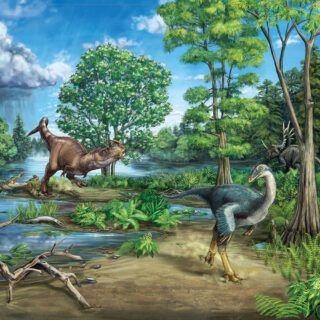
Image by Danielle Dufault, Royal Ontario Museum.
This Cretaceous-Paleogene, or K-Pg, extinction event, is what caused the extinction of non-avian dinosaurs. After the asteroid hit, there came a period of “nuclear winter.” The impact itself kicked up so much dust and other matter into the atmosphere that sunlight was blocked. Massive fires caused by the heat of the impact brought soot and an increase in carbon dioxide levels, raising the temperature of the planet. Acid rain fell, and photosynthesis paused.
That’s the dark history that we’ve come to remember about the K-Pg event—no signs of life, no glimmer of hope. When looking at the fallout of a mass extinction, it’s easy to forget about what survived.
Until ferns entered the picture. Their story is one of survival, of perseverance in a post-extinction world. Today, as our planet faces drastic environmental changes, the history of ferns, and work by scientists like NYBG’s Dr. Emily Sessa, can give us insights into how plants will adapt, and how that in turn will impact people.
And surprisingly, for a story that starts with a mass extinction, it can also bring hope.
In the early 1980s, a spike of iridium was found in the fossil record in western North America. Iridium is an element that is rarely found on Earth, but is very common in extraterrestrial rocks like meteors and asteroids. This “iridium anomaly” was found at the rock layer that corresponds to the Cretaceous-Paleogene period.
Where the iridium anomaly exists in the fossil record, scientists also found a huge spike in fern spores, meaning a rock layer containing lots of these spores was found just above the layer with iridium. If we look at the pollen and spore record (plant spores, fungal spores, and pollen grains preserved in sediments) before the Cretaceous-Paleogene period, we find mostly angiosperms (flowering plants), with about 20% ferns. After the asteroid hits, it jumps to almost 100% ferns. Out of everything producing pollen and spores, ferns were the only plants being picked up in the record.
Scientists quickly realized that you could find this “fern spore spike” anywhere that you found the iridium anomaly – it is so prevalent worldwide that the spore spike also came to be recognized as a marker of the K-Pg mass extinction event.
“It’s really important to think about the vegetation that made up the greenery on the planet that all those big animals were wandering around in and eating, and ferns were a big part of that,” said Dr. Emily Sessa. As we touched on in the last blog post, which introduced Sessa, she is the Director of NYBG’s William and Lynda Steere Herbarium, and also a scientist dedicated to researching ferns.
“Even though this fern spike has been recognized since the early 80s, nobody ever asked why. And that’s what we set out to do.”
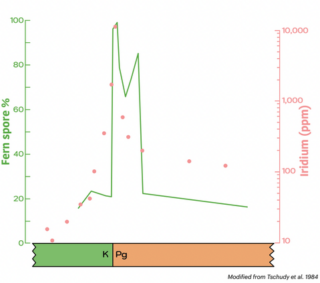
Graph modified from Disruption of the Terrestrial Plant Ecosystem at the Cretaceous-Tertiary Boundary, Western Interior Tschudy et al., 1984, Science: 225
What started as an idea on a cocktail napkin became a NASA-funded project to explore the recovery of ferns in the post-extinction world. Sessa and her colleague, Dr. Jarmila Pittermann, a professor of plant physiology at University of California–Santa Cruz, were discussing how they might seek a grant from NASA’s Exobiology program. Though “exobiology” is often defined as life on other planets, NASA defines it as a way of understanding the evolution of life in the universe. That includes Earth—and possibly planets beyond it.
Knowing that they shared a passion for ferns, Sessa and Pittermann decided to apply for a grant through the Exobiology program. Studying how ferns reacted to the K-Pg event, and the conditions that arose after during the the early Paleogene, could lead to understanding how plants might react on other planets with unhospitable conditions, like Mars, or in rapidly changing environments on Earth.
They brought on Dr. Jacquelyn Gill, Associate Professor of Paleoecology & Plant Ecology at the University of Maine, Dr. Ellen Currano, Professor of Geology and Geophysics at the University of Wyoming, and Dr. Regan Dunn, a paleobotanist and Assistant Curator at the La Brea Tar Pits, part of the Natural History Museum of Los Angeles County.
The project has two goals:
- A paleo-vegetation piece: together, these scientists are working to reconstruct the plant communities right before and right after the extinction event, using fern fossils as a guide
- An experimental component, to research the physiological responses of these plants in post-mass-extinction conditions – especially the ferns.
Shockingly, it’s not hard to simulate a mass extinction event. The ingredient list is simple: dark, cold, high concentrations of carbon dioxide, and acid rain. Mix it up, and you’ve got a recipe for disaster.
In Santa Cruz, at Pittermann’s lab, scientists worked in the greenhouse to study how fern sporophytes reacted to the nuclear winter conditions. In Sessa’s lab at the University of Florida, where she was a professor before joining NYBG, research in growth chambers focused on how gametophytes responded.
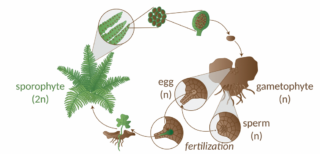
Illustration of the fern life cycle by Emily Sessa. The sporophyte drawing is by Tracey Saxby and is used under a Creative Commons open license from the IAN Image Library.
What are sporophytes and gametophytes exactly? Well, they’re part of the reason why ferns are so fascinating.
Sporophytes are the stage of a plant’s life cycle that we’re usually most familiar with—big and green, with lots of leaves. Sporophytes produce spores, which will each germinate into a gametophyte, and the gametophytes makes the eggs and sperm. Once fertilization occurs, a new sporophyte results, and the cycle continues. In flowering plants, the spore and gametophyte are hidden from plain sight, packed inside either seeds or pollen grains. But in ferns, the dust-like spores themselves leave the parent plant, are dispersed far and wide by the wind, and when they land, the gametophyte that germinates will be a tiny, independent and free-living little plant.
“Hardly anyone ever thinks about them, even among scientists…they’re very overlooked,” said Sessa. “My research over the years has increasingly focused on this gametophyte generation, because they’re so important – if you want another big, leafy sporophyte fern plant, the gametophyte has to be able to establish itself and survive.”
Understanding how gametophtyes responded after the K-Pg event is critical to understanding the fern spore spike.
During the experiment, a team of students grew gametophytes of several fern species on petri dishes, and evaluated how they performed in control conditions versus the post-mass-extinction conditions.
This experiment resulted in a couple of important findings about fern spores and gametophytes in the nuclear winter-like treatment.
“It took the spores longer to germinate, by a few days,” said Sessa. “But then, once the gametophytes got going, we found that those in the more challenging treatments were actually less stressed than the ones in the control conditions.”
Though the research team expected the ferns would be able to survive, knowing the fern spike occurred, Sessa said it was important to actually use an experiment to see how fern gametophytes behave under multiple stressors associated with the mass extinction: light, acid, carbon dioxide, and temperature.
The result? Ferns aren’t going anywhere.
“The big picture is, they are very well equipped to deal with a wide range of different stressors,” said Sessa. “Not only did they survive, they seemed to thrive in that environment.”
Based on these results and the results of previous studies, fern gametophytes could have handled the conditions of a post-extinction world.
Out west, in Pittermann’s lab at UC Santa Cruz, results were similar: after the ferns went through the conditions of the K-Pg event, they lay dormant. But after a while, a small green tendril emerged. They had survived.
Why are ferns so resilient?
- They have a special type of photoreceptor that allows them to photosynthesize in low light conditions.
- They are tolerant of acidic and nutrient-poor soils.
- Some species can even absorb heavy metals from contaminated soil.
- Their metabolism is slower, so they can focus on building underground resources.
- Their unique root and stem system gives them an advantage.
“If a flower is cut to the ground, it can be hard to recover from that,” said Sessa. “Ferns are quite different in that everything you see above the ground basically is leaf, and their stems run horizontally underground.”
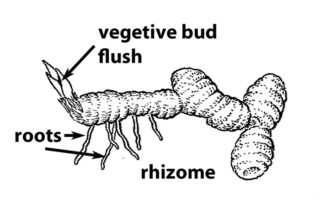
Image by B. Angell, Mertz Library
Ferns have rhizomes: subterranean plant stems that produce roots below ground, and send up shoots toward the surface. They can also store food and transport water and nutrients to other parts of the plant. Because the fern’s rhizome grows horizontally and fully underground, it can be buried quite deep and persist with nutrient storage, even if the leaves are damaged.
“Something we didn’t study, but that would have been interesting to look at, would have been the effects of fire,” said Sessa. “When that asteroid hit, the initial response was a fireball. It would have been wildfires on a scale we can’t really comprehend. There’s been a discussion about the scouring of the surface of the Earth…but fern rhizomes might have been buried meters down in the soil, which could have allowed them to recover more quickly than other plants.”
And let’s not underestimate the importance of those small-but-mighty gametophytes. By being hardy enough to tolerate the harsh conditions in the post-extinction world, as the experiment revealed, the reproductive cycle continued, and ferns lived on.
As Sessa said in an interview with the Los Angeles Times, “[ferns] basically just act as the first pioneer or colonizer species that are able to get a hold on a devastated kind of landscape and start to bring some life back to it.”
So, what’s the point? Why are we studying an event that happened more than 60 million years ago?
“There’s a lot of relevance to today because we’re in the midst of a mass extinction now,” said Sessa, referring to anthropogenic climate change. “Understanding how all of life on Earth and how biodiversity in general responded to these periods of massive environmental change in the past has relevance to the planet we’re living on today.”
As the climate warms, plants are also changing in ways that are likely to affect us and our ability to survive. Though there is merit in studying the history of fauna, like dinosaurs, plants can tell us just as much about our history and our future.
“Plants provide the oxygen we breathe, materials we use to cloth and house ourselves, and they’re the basis of our food systems ,” said Sessa. “Understanding how environmental change effects plants is essential for safeguarding ourselves.”
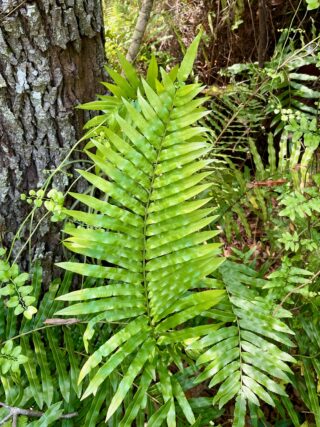
Fronds of Telmatoblechnum serrulatum, one of the species used in Sessa’s study. Photo by Emily Sessa.
What concerns her most is that we are altering the trajectory of life on the planet—something we cannot undo.
“What we’re changing is the pace. That really is what human induced climate change is,” Sessa pointed out. “The planet has been through worse, but it has never experienced change at the pace that we are causing it now. There really is no analog for that.”
One of the other researchers on the project, Dr. Jacquelyn Gill, studies what are called “no analog” communities, which do not exist on earth today, and have no comparison in the fossil record. As the earth warms, the ranges of species are shifting—climate change, human disturbances, and invasive species are all causing communities to move past the limits of their native ranges. Because of this, there will be plants and animals living together that didn’t previously, creating new types of communities that don’t currently exist. Based on Gill’s research, Sessa said this could be a reason for hope. These communities may be new, but the climate has changed drastically before, forcing species to live together—and life has gone on.
“Ecosystems are in flux, and we shouldn’t think about now as the be-all-end-all of the planet,” said Sessa. “Plants have nearly a billion years of history… there is a lot of genetic variability, and there will be adaptation and evolution in response to this.”
By studying the past, we not only try to mitigate the ways humans are negatively impacting the Earth, but we can also find hope in discovering resilience, sometimes in the most unexpected places.
“I think what’s compelling about the fern spore spike,” said Sessa, “is the fact that you could have the planet nearly wiped clean of life, and then these plants—not the ones you would expect, the ones most people never think about—are the first ones to come back.”
SUBSCRIBE
Enter your email address to subscribe to this blog and receive updates on new posts.











